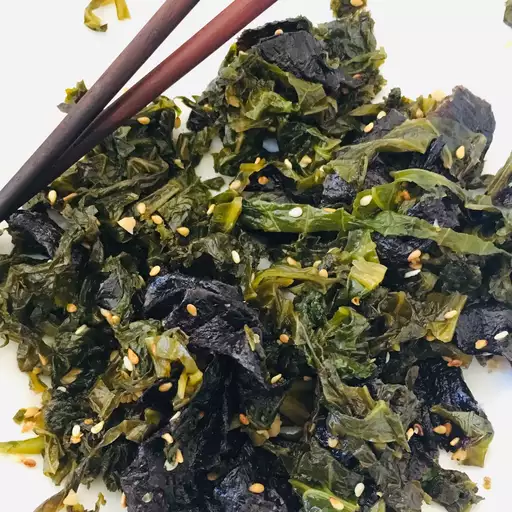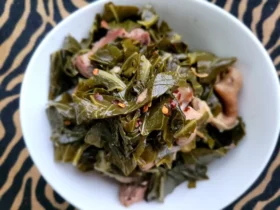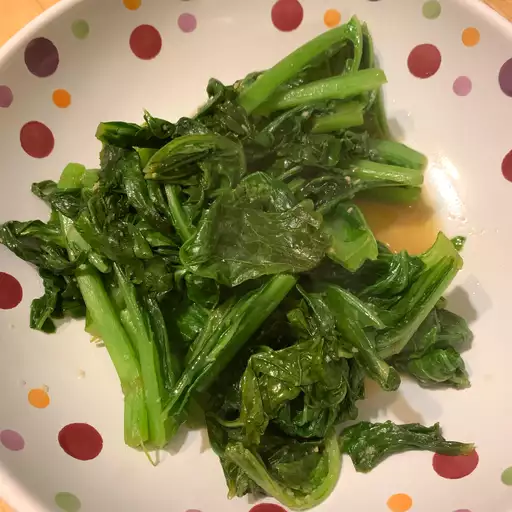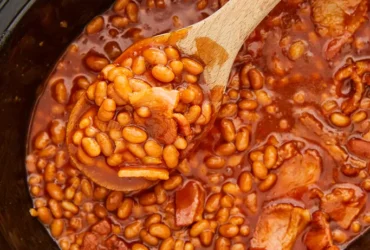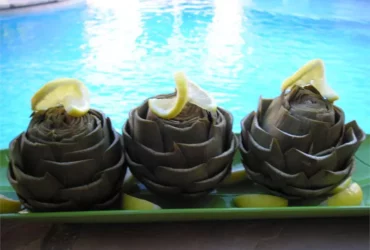Ingredients
Basics
In this recipe for Asian-inspired mustard greens, you’ll need to focus on selecting high-quality ingredients that will enhance the flavors and textures of the dish.
For the mustard greens, look for fresh bunches with crisp leaves and a vibrant green color. They should be slightly bitter in taste and have a firm texture.
As for the aromatics, you’ll need to chop up some onions, garlic, and ginger to create the foundation of the dish’s flavor profile. Choose yellow or white onions that are sweet and mild, while avoiding red onions which can add too much of a pungent taste.
Garlic should be firm and have a dry texture with no signs of sprouting. For this recipe, you’ll need about 3-4 cloves, minced to bring out their natural oils and flavors.
Ginger adds a warm and spicy element to the dish. Opt for fresh ginger that’s firm to the touch and has a smooth skin without any wrinkles or soft spots. You’ll only need a small piece of about 1-inch in length, peeled and grated to release its flavor compounds.
For the protein component, you can use chicken breast or thighs, depending on your preference. Choose fresh meat with no visible signs of aging or discoloration, and trim any excess fat for even cooking.
Oyster sauce is a key ingredient in this Asian-inspired dish that adds a rich savory flavor. Look for a high-quality brand that’s made from real oysters and has a thick syrupy texture.
Finally, you’ll need some soy sauce to bring out the umami flavors of the other ingredients. Choose a light or regular soy sauce depending on your taste preferences, but avoid using low-sodium options which may lack depth and complexity.
To balance out the dish’s savory flavors, add some vinegar such as rice vinegar or apple cider vinegar in moderation, taking care not to overpower the other flavors.
Optional ingredients like chili flakes or sambal oelek can be added to give the dish a spicy kick, but feel free to adjust the amount according to your desired level of spiciness.
A pinch of salt is all you’ll need to bring out the natural sweetness in the ingredients and balance the flavors. Be mindful not to over-salt, as this can easily happen with Asian-style cooking.
1 bunch of mustard greens
The star ingredient in our Asian-Inspired Mustard Greens recipe is a bunch of mustard greens, also known as Brassica juncea. This leafy green vegetable is a staple in many Asian cuisines and adds a unique flavor and texture to dishes.
What are Mustard Greens?
Mustard greens are a type of leafy green that belongs to the Brassicaceae family, which includes broccoli, cauliflower, and kale. They are a cool-season crop, typically grown in the fall or early spring, and are prized for their distinctive flavor and nutritional benefits.
Characteristics of Mustard Greens
Mustard greens have several key characteristics that set them apart from other leafy greens:
- Distinctive Flavor: Mustard greens have a pungent, slightly bitter taste that is often described as spicy or peppery.
- Rough Texture: The leaves of mustard greens are typically thick and rough to the touch, with a slight crunch when bitten into.
- High in Nutrients: Mustard greens are rich in vitamins A, C, and K, as well as minerals like calcium and iron.
Culinary Uses of Mustard Greens
Mustard greens can be used in a variety of dishes, from soups and stews to stir-fries and salads. In Asian cuisine, they are often stir-fried with garlic and chili peppers to add flavor and heat to dishes.
- Stir-Fries: Mustard greens make a great addition to stir-fries, where their bold flavor can stand up to other ingredients like protein, vegetables, and sauces.
- Salads: The slightly bitter taste of mustard greens pairs well with sweet or tangy flavors in salads.
- Soups: Mustard greens can be added to soups for a burst of flavor and nutrients.
Choosing Fresh Mustard Greens
If you’re using fresh mustard greens, choose bunches with crisp, dark green leaves. Avoid wilted or yellowing leaves, as they may have lost their flavor and nutritional value. Check the stem ends for any signs of bruising or damage.
Preparation and Storage
To prepare fresh mustard greens, remove the stems by cutting off the leafy ends and discarding them. You can then chop the leaves into smaller pieces or leave them whole, depending on your desired use. Mustard greens can be stored in the refrigerator for up to 5 days, wrapped in plastic wrap or aluminum foil.
Cooking Methods
Mustard greens can be cooked using a variety of methods, including sautéing, steaming, and boiling. Here are some tips:
- Sautéing: Heat oil in a pan over medium-high heat and add chopped mustard greens. Cook until the leaves are wilted and tender.
- Steaming: Place mustard greens in a steamer basket and steam for 5-10 minutes, or until tender.
- Boiling: Boil chopped mustard greens in water or broth for 5-10 minutes, or until tender.
In our Asian-Inspired Mustard Greens recipe, we use a combination of stir-frying and steaming to bring out the full flavor and nutritional value of this delicious leafy green!
2 cloves of garlic
For this Asian-inspired mustard greens recipe, you will need to use 2 cloves of garlic as a key ingredient.
The garlic should be fresh and firm, with no signs of sprouting or mold.
To properly prepare the garlic for cooking, peel each clove using a gentle touch to avoid damaging it.
Peeling the garlic will help release its natural oils and enhance its aroma.
You can use either yellow or white garlic for this recipe, as both varieties have a pungent flavor that pairs well with mustard greens.
If you’re using fresh garlic, be sure to store it in an airtight container at room temperature until ready to use.
However, if you’re using pre-minced or pre-peeled garlic from a jar, make sure to check the expiration date and follow proper storage instructions.
For this recipe, it’s essential to note that 2 cloves of garlic is a moderate amount, which will add depth without overpowering the other flavors.
You can always adjust the amount of garlic to your taste preferences, but for this particular dish, 2 cloves are recommended.
Once you’ve prepared and measured out the correct amount of garlic, chop it finely to release its flavors and aroma further.
Now that you have all the ingredients, including 2 cloves of garlic, you can proceed with combining them with other essential components of this Asian-inspired mustard greens recipe.
This dish will result in a harmonious blend of flavors and textures, showcasing the perfect balance between East meets West.
The pungency of the garlic, combined with the slightly bitter taste of mustard greens, is an excellent example of how contrasting flavors can complement each other beautifully in Asian cuisine.
1 tablespoon of vegetable oil
A key ingredient in many Asian-inspired dishes, including our Asian-Inspired Mustard Greens Recipe, vegetable oil plays a crucial role in enhancing the flavor and aroma of the dish.
One tablespoon of vegetable oil is typically used to sauté or stir-fry ingredients at the beginning of cooking, helping to bring out their natural flavors and textures.
Why Vegetable Oil?
In Asian cuisine, vegetable oil is often preferred over other oils due to its mild flavor and high smoke point, making it ideal for high-heat cooking.
Types of Vegetable Oil
- Cottonseed oil: A popular choice in many Asian recipes, cottonseed oil has a neutral flavor and a light texture that complements the delicate flavors of mustard greens.
- Soybean oil: Another common type of vegetable oil used in Asian cooking, soybean oil has a slightly nutty flavor and is often used for stir-frying and sautéing ingredients.
Using Vegetable Oil in Cooking
To use vegetable oil in your cooking, heat one tablespoon of the oil in a wok or large skillet over medium-high heat until it reaches its smoke point.
Add your aromatics, such as garlic and ginger, to the hot oil and sauté for about 30 seconds before adding other ingredients, like mustard greens and protein sources.
Continue cooking, stirring occasionally, until all ingredients are tender and well coated with the flavors of the dish.
In our Asian-Inspired Mustard Greens Recipe, we use vegetable oil to create a rich, savory sauce that pairs perfectly with the slightly bitter flavor of mustard greens.
Flavor Enhancers
In the realm of cooking, ingredients play a vital role in bringing out the flavors and aromas that elevate dishes to new heights. For an Asian-inspired mustard greens recipe, it’s essential to select ingredients that complement each other harmoniously.
The star of the show here is, of course, the mustard greens themselves. These leafy greens are a staple in many Asian cuisines, particularly in Chinese and Southeast Asian cooking. They possess a unique peppery flavor that adds depth and complexity to dishes.
Other key ingredients in this recipe include garlic, ginger, and sesame oil. Garlic and ginger are aromatic staples in many Asian dishes, adding a pungent flavor that pairs perfectly with the mustard greens. Sesame oil, with its nutty and slightly sweet flavor, helps bring all these flavors together.
Salt and sugar are also crucial ingredients in this recipe. Salt enhances the natural flavors of the vegetables, while sugar balances out the bitterness of the greens. In many Asian dishes, sugar is used to balance out savory flavors and create a sense of harmony.
Now, let’s talk about flavor enhancers. These are ingredients that amplify the flavors of other ingredients without overpowering them. In this recipe, soy sauce and rice vinegar are excellent examples of flavor enhancers. Soy sauce adds a rich, savory umami flavor, while rice vinegar provides a tangy, slightly sweet flavor.
Another crucial flavor enhancer is five-spice powder, a blend of spices commonly used in Chinese cooking. This blend typically includes cinnamon, cloves, fennel seeds, star anise, and Szechuan peppercorns. Five-spice powder adds warmth and depth to dishes without overpowering the other flavors.
Lastly, we have chili flakes or sriracha sauce, which add a spicy kick to the dish. In many Asian cultures, spicy food is believed to stimulate digestion and improve circulation. These ingredients not only add flavor but also serve as a catalyst for the body’s natural healing processes.
1 teaspoon of soy sauce
The ingredients for this Asian-inspired mustard greens recipe are carefully selected to bring out the unique flavors and textures of the dish.
One of the key ingredients in this recipe is soy sauce, which adds a savory umami flavor that complements the bitterness of the mustard greens.
Here’s a breakdown of the soy sauce used in this recipe:
- Type: Soy sauce is a fermented soybean paste that has been made from soybeans and salt. It is commonly used in Asian cooking to add depth and umami flavor to dishes.
- Quantity: The recipe calls for 1 teaspoon of soy sauce, which may seem like a small amount, but trust us, it makes all the difference in bringing out the flavors of the mustard greens.
- Purpose: The soy sauce is added to the pan with the garlic and ginger to create a savory sauce that coats the mustard greens. It’s also used as a marinade for the tofu to give it a rich, depthful flavor.
When selecting a soy sauce for this recipe, look for one that is made from fermented soybeans and has a rich, savory flavor. Some popular brands of soy sauce include Kikkoman and Pearl River Bridge. You can also make your own homemade soy sauce using fermented soybeans and salt.
Remember to always use the right amount of soy sauce to balance out the flavors in the dish. Too much soy sauce can overpower the other ingredients, while too little may not provide enough umami flavor. Experiment with different amounts and ratios of soy sauce to find what works best for you.
1 teaspoon of grated fresh ginger
The use of ginger adds a warm and aromatic flavor to the dish, making it a crucial ingredient in many Asian-inspired recipes, including this Mustard Greens recipe.
In this specific recipe, we call for 1 teaspoon of grated fresh ginger, which provides a subtle yet noticeable depth of flavor. Fresh ginger has a more vibrant and intense flavor compared to dried ginger, making it the preferred choice in this case.
The key is to grate the ginger finely using a microplane or a fine grater, allowing its natural oils to release and infuse into the dish. This ensures that the ginger’s potent flavor compounds are evenly distributed throughout the recipe.
It’s worth noting that you can also use crystallized ginger as an alternative, but fresh ginger is generally preferred for its fresher taste and aroma.
When it comes to measuring out 1 teaspoon of grated ginger, make sure to level off the grater to ensure accuracy. You don’t want too much or too little ginger affecting the overall balance of flavors in your dish.
1/4 teaspoon of red pepper flakes
The use of red pepper flakes as an ingredient in this Asian-inspired mustard greens recipe serves a crucial purpose in enhancing the overall flavor profile of the dish.
Red pepper flakes, which are made from dried and crushed red chili peppers, add a spicy kick to the mustard greens, contributing to their bold and aromatic taste.
The addition of only 1/4 teaspoon of red pepper flakes is deliberate, as this amount allows for a subtle yet noticeable level of heat to be introduced into the dish without overpowering its other flavors.
When used in conjunction with the other ingredients in the recipe, such as garlic, ginger, soy sauce, and sesame oil, the red pepper flakes work together to create a harmonious balance of sweet, sour, salty, and spicy notes.
The heat from the red pepper flakes also helps to counterbalance the bitterness of the mustard greens, resulting in a more rounded and palatable flavor experience for the consumer.
Furthermore, the use of red pepper flakes in this recipe is consistent with traditional Asian culinary practices, which often employ chili peppers or their derivatives as a key ingredient to add depth and complexity to various dishes.
The moderate amount of heat introduced by the 1/4 teaspoon of red pepper flakes also allows for versatility in terms of serving temperature, as the dish can be served hot, warm, or even at room temperature without sacrificing its overall flavor and aroma.
Preparation and Cooking
Washing and Chopping
To prepare this Asian-Inspired Mustard Greens Recipe, it’s essential to follow proper techniques for washing and chopping the greens, as well as preparing any accompanying ingredients.
Washing the Mustard Greens: Before you begin, it’s crucial to rinse the mustard greens thoroughly under cold running water. Gently remove any debris or dirt from the leaves by grasping the stems and swirling them in a circular motion.
This process helps to loosen any residual impurities and prevents the spread of contamination. Repeat this step several times until you’re confident that your greens are clean.
Drying the Mustard Greens: After washing, use a salad spinner or lay out the mustard greens on a paper towel-lined plate to dry. This helps to remove excess moisture from the leaves, which will make them easier to handle when it’s time for cooking.
Once your greens are dry, pat them gently with a clean kitchen towel to absorb any remaining moisture.
Chopping the Mustard Greens: For this recipe, you’ll need to chop the mustard greens into thin strips. Hold each leaf by the stem and cut it into 2-3 inch pieces using a sharp knife.
Work in a gentle rocking motion with your wrist as you cut through the leaves to prevent bruising or tearing. Continue this process until all of the greens are chopped to the desired size.
Preparing Other Ingredients: While you’re chopping the mustard greens, take a moment to prepare any additional ingredients called for in the recipe, such as garlic, ginger, or sesame seeds.
This ensures that everything is ready to go when it’s time to combine all of the components and start cooking your Asian-Inspired Mustard Greens Recipe.
Remove the stems from the mustard greens and chop them into small pieces
To prepare and cook for an Asian-Inspired Mustard Greens Recipe, follow these steps:
Preparation
The first step in preparing mustard greens is to remove their stems.
Here’s how to do it:
- Start by holding a bunch of mustard greens in one hand and locate the stem, which is usually thicker than the leaves.
- Gently pinch or cut off the stem at its base using kitchen shears or a sharp knife.
- Continue to repeat this process for each bunch of mustard greens you are using in the recipe.
After removing the stems, chop the leaves into small pieces. This will help them cook more evenly and quickly.
Here’s a step-by-step guide on how to chop the mustard green leaves:
- Gather a handful of chopped mustard greens in one hand, with the leafy parts facing upwards.
- Using kitchen shears or a sharp knife, cut along both sides of the stem, making parallel cuts about 1-2 inches apart. This will help break down the leaves into smaller pieces.
- Continue to chop the mustard greens until they are finely chopped and have reached your desired texture.
Cooking
To cook the chopped mustard greens, follow these steps:
- In a large wok or frying pan, heat some oil over medium-high heat. You can use vegetable oil, peanut oil, or any other oil of your choice.
- Add some aromatics such as minced garlic and ginger to the pan and stir-fry until fragrant.
- Next, add the chopped mustard greens to the pan and stir-fry for about 3-5 minutes, or until they start to wilt. You can also add some soy sauce or oyster sauce to enhance the flavor.
- Continue to stir-fry the mustard greens for another 2-3 minutes, or until they are tender but still crisp. Season with salt and pepper to taste.
Once cooked, serve the Asian-Inspired Mustard Greens Recipe as a side dish or add it to your favorite noodles, rice bowls, or stir-fries for added nutrition and flavor.
Wash the chopped greens in cold water to remove any dirt or debris
To begin preparing for this Asian-Inspired Mustard Greens recipe, it’s essential to handle the chopped greens with care to ensure they’re clean and free from any dirt or debris.
Start by filling a large bowl with cold water. This will be used to wash the chopped greens thoroughly.
Select the freshest bunch of mustard greens you can find, ideally ones with crisp leaves and no signs of wilting or discoloration.
Rinse each leaf under running cold water to remove any dirt or debris that may have accumulated on their surface.
Next, transfer the washed leaves to the large bowl filled with cold water. Submerge all the leaves completely in the water.
Allow the greens to soak for a few minutes to help dislodge any remaining dirt or debris.
After soaking, gently agitate the water by swirling your hands through it to release any dirt that may have been loosened during the soaking process.
Inspect each leaf carefully and repeat the washing process if necessary. This ensures that all leaves are completely clean before proceeding with the recipe.
Washing Methods
- Bowl Washing Method: This is the method described above, where you submerge the greens in a bowl of cold water to wash them thoroughly.
- Sink or Large Container Washing Method: If you have access to a sink or large container with enough space to hold the greens, you can use this method. Fill the sink or container with cold water and gently submerge the leaves to wash them.
Tips for Washing Mustard Greens
- Use cold water to prevent bruising the leaves.
- Soak the greens long enough to loosen any dirt or debris, but not so long that they become soggy.
- Repeat washing if necessary to ensure all leaves are clean.
After washing and rinsing your chopped mustard greens, pat them dry with paper towels to remove excess moisture. This will help prevent the greens from becoming soggy during cooking.
Cooking Methods
In preparing for an Asian-inspired mustard greens recipe, it’s essential to start by selecting fresh and high-quality mustard greens.
Choose a bunch with vibrant green leaves, crisp stems, and no signs of wilting or browning.
Next, wash the mustard greens thoroughly under cold running water to remove any dirt or debris.
Gently pat the leaves dry with paper towels to prevent excess moisture from affecting the cooking process.
Cut and Prep the Mustard Greens
- Cut off the stems of the mustard greens, discarding them or saving them for another use in soups or stews.
- Stack the leaves on top of each other and roll them into a tight cylinder to facilitate even cutting.
- Cut the rolled mustard greens into thin strips, about 1-2 inches long.
Cooking Methods for Mustard Greens
There are several cooking methods that can be used to prepare mustard greens, including steaming, sautéing, and stir-frying:
- Steaming: This method helps retain the nutrients in the mustard greens while maintaining their crisp texture. Simply place the chopped mustard greens in a steamer basket over boiling water for 3-5 minutes.
- Sautéing: Heat some oil in a wok or large skillet over medium-high heat and add the chopped mustard greens, cooking until they’re wilted and tender. Season with soy sauce, garlic, and ginger for added flavor.
- Stir-frying: Stir-fry sliced mushrooms, bell peppers, and onions in a wok or large skillet with some oil before adding the chopped mustard greens and cooking until everything is well combined and heated through. Serve over rice or noodles for a filling meal.
Adding Flavors to Mustard Greens
To add extra flavors to your Asian-inspired mustard greens recipe, try the following:
- Soy sauce: Use soy sauce as a marinade or seasoning to add depth and umami flavor to the mustard greens.
- Ginger and garlic: Saute minced ginger and garlic with the mustard greens for added aroma and warmth.
- Chili flakes or sriracha: Add some heat to your mustard greens by sprinkling chili flakes or sriracha on top before serving.
These cooking methods and flavor combinations will help you create a delicious and authentic Asian-inspired mustard greens recipe that’s sure to become a favorite in your household.
Sauté the chopped garlic and ginger in oil until fragrant
To prepare for sautéing the chopped garlic and ginger, start by gathering all the necessary ingredients and tools within easy reach. This includes a cutting board for chopping the garlic and ginger, a chef’s knife for mincing them, a small bowl or ramekin for holding the oil, and a medium-sized skillet or wok that can withstand high heat.
Select a high-quality oil with a smoke point suitable for sautéing at higher temperatures. Options like peanut oil, avocado oil, or grapeseed oil work well. If you prefer to use butter or another type of fat, make sure it can handle the heat and doesn’t smoke or burn easily.
Mince the garlic cloves until they’re finely chopped. The key is to aim for a uniform size so that the garlic cooks evenly. You want the pieces small enough that they’ll quickly soften in the hot oil but large enough that they retain their texture and flavor.
Next, mince the ginger according to your preference. Some people like to grate it, while others prefer it minced. Grating adds a bit more surface area for cooking but can result in uneven sizes; mincing helps maintain consistency.
Now, heat about 1-2 tablespoons of oil over medium-high heat in the skillet or wok. Once the oil is hot, carefully place the chopped garlic and ginger into it. You want to avoid splashing the hot oil onto yourself or other surfaces, so do this with a gentle pour.
Allow the mixture to cook for about 1-2 minutes, or until you notice the fragrance of the garlic and ginger filling the air. They should start to soften slightly and take on a light golden color. Be mindful not to let them burn; you can adjust the heat as needed to prevent this.
Once fragrant, remove the skillet from the heat source if it’s heating too quickly or aggressively. Proceed with your recipe according to the instructions provided in the original article or video, incorporating these sautéed aromatics into the overall dish.
Add the chopped mustard greens, soy sauce, and red pepper flakes to the pan and stirfry until the leaves are wilted
To prepare and cook the Asian-inspired mustard greens, it’s essential to start with some key ingredients. First, heat a tablespoon of vegetable oil in a large skillet or wok over medium-high heat. Once the oil is hot, add 1-2 cloves of minced garlic and sauté for about 30 seconds until fragrant.
Next, add the chopped mustard greens to the pan and stir-fry them with the garlic for about 3-4 minutes or until they start to wilt. Be sure to stir frequently to prevent burning. If using frozen mustard greens, let them thaw first before chopping them.
Now it’s time to add some flavorings to bring out the authentic Asian taste in your dish. Add 1 tablespoon of chopped fresh ginger and sauté for another minute, allowing its aroma to blend with that of the garlic and greens.
Add a teaspoon of soy sauce to the pan and stir-fry the mixture well. Soy sauce is a staple in many Asian cuisines, providing depth and umami flavor to dishes. If you’re looking for an added kick, sprinkle some red pepper flakes on top and stir-fry until combined. Red pepper flakes add a spicy touch that pairs perfectly with the slightly bitter taste of mustard greens.
Finally, add 1/4 cup of chopped scallions or green onions to the pan and stir-fry for about 2 minutes or until they’re well-combined with the other ingredients. Your Asian-inspired mustard greens recipe is now ready to be served!
Remember, the key to a delicious and flavorful dish is in the combination of ingredients and techniques used. Experiment with different flavorings and seasonings to create your unique version of this classic Asian-inspired recipe.
To complete the experience, serve the mustard greens hot, garnished with additional chopped scallions or sesame seeds if desired. This Asian-inspired mustard greens recipe is perfect as a side dish for stir-fries, noodle bowls, or even as a standalone meal.
Nutrition and Variations
Health Benefits
The realm of nutrition is a vast and wondrous place, full of diverse ingredients and variations that offer a multitude of health benefits. When it comes to incorporating new foods into our diets, we often overlook the humble mustard green. Native to Asia, this leafy green has been used in various forms for centuries, providing an array of benefits to those who consume it.
One of the primary advantages of mustard greens is their rich storehouse of vitamins and minerals. They are an excellent source of vitamin A, which plays a crucial role in maintaining healthy vision, immune function, and skin health. Additionally, they are packed with folate, vitamin K, and iron, making them a valuable addition to a well-rounded diet.
The variations of mustard greens are numerous and can be grouped into several distinct categories. Some common types include:
- Mizuna: A Japanese variety known for its delicate flavor and crunchy texture
- Tatsoi: A Chinese green with a slightly bitter taste and thick, succulent leaves
- Green mustard: A European type characterized by its peppery flavor and dense, flat leaves
Health benefits associated with mustard greens include:
- Anti-Inflammatory Properties: Mustard greens contain various polyphenols that have been shown to reduce inflammation in the body.
- Antioxidant Activity: These leafy greens are rich in antioxidants, which help protect cells from damage caused by free radicals.
- Cancer Prevention: Some studies suggest that consuming mustard greens may lower the risk of certain cancers due to their high content of isothiocyanates.
In the context of our Asian-Inspired Mustard Greens Recipe, we will be highlighting the unique flavors and textures of mizuna and tatsoi varieties. These leafy greens can be used in a variety of dishes, from salads to stir-fries, providing a burst of color, texture, and nutrients to any meal.
Mustard greens are high in vitamins A, C, and K, as well as minerals like calcium and iron
Mustard greens are a nutrient-dense leafy green vegetable that offers numerous health benefits when consumed as part of a balanced diet. One of their standout features is their high content of essential vitamins and minerals, making them an excellent addition to various dishes, including Asian-inspired recipes.
Rich in vitamins A, C, and K, mustard greens play a vital role in maintaining healthy vision, immune function, and bone health. Vitamin A is crucial for the proper functioning of the retina and mucous membranes, while vitamin C is a powerful antioxidant that helps protect cells from damage caused by free radicals.
The high content of vitamin K in mustard greens makes them an excellent source for promoting bone health and preventing blood clotting disorders. This vitamin is essential for the production of clotting factors in the liver, which helps to prevent excessive bleeding and bruising.
In addition to these essential vitamins, mustard greens are also a rich source of minerals like calcium and iron. Calcium is vital for building and maintaining strong bones and teeth, while iron plays a crucial role in transporting oxygen throughout the body. Iron deficiency can lead to anemia, a condition characterized by fatigue, weakness, and shortness of breath.
The unique flavor profile of mustard greens makes them an excellent addition to various Asian-inspired dishes, including stir-fries, soups, and salads. Their slightly bitter taste is balanced by their earthy undertones, making them a versatile ingredient that can be used in both sweet and savory recipes.
In the context of this Asian-inspired recipe for mustard greens, the use of umami-rich ingredients like soy sauce and sesame oil enhances the natural flavor of the greens. The addition of aromatics like garlic and ginger adds depth and complexity to the dish, while the protein source of your choice (chicken or tofu) provides a satisfying crunch.
The key to preparing mustard greens is to cook them until they are tender but still retain some crunch. Overcooking can lead to a mushy texture that overpowers the delicate flavor of the greens. By cooking them with aromatics and spices, you can bring out their natural sweetness and create a delicious side dish or main course.
In summary, mustard greens are an excellent addition to any diet due to their high content of essential vitamins and minerals. Their unique flavor profile makes them an ideal ingredient for Asian-inspired recipes, and their versatility allows them to be used in both sweet and savory dishes. By cooking them with aromatics and spices, you can create a delicious and nutritious side dish or main course that is sure to please even the most discerning palates.
They contain antioxidants that may help reduce inflammation and improve heart health
Nutrition plays a vital role in our overall well-being, and understanding its importance can help us make informed choices about what we eat. When it comes to leafy greens like mustard greens, they are packed with nutrients that provide numerous health benefits.
One of the key components of these greens is their antioxidant content. Antioxidants are molecules that help neutralize free radicals in the body, which can cause oxidative stress and lead to inflammation. Chronic inflammation has been linked to a range of diseases, including heart disease, diabetes, and certain types of cancer.
The antioxidants present in mustard greens may help reduce inflammation by scavenging for free radicals and preventing them from causing damage to cells and tissues. This can contribute to improved overall health and well-being, as well as reduced risk of chronic diseases.
Additionally, the nutrient profile of mustard greens includes high levels of vitamins A, C, and K, as well as minerals like calcium and iron. These nutrients are essential for maintaining healthy skin, hair, and nails, while also supporting immune function and energy production.
The antioxidants and other nutrients in mustard greens may also help improve heart health by reducing inflammation and improving blood vessel function. This can contribute to a lower risk of cardiovascular disease and stroke, making them an excellent addition to a balanced diet.
When preparing mustard greens for the Asian-Inspired Mustard Greens Recipe, it’s essential to choose fresh leaves with minimal damage or discoloration. Wash the greens thoroughly before using them in the recipe to ensure they are free of any impurities or contaminants.
The combination of flavors and textures in this recipe is designed to showcase the natural sweetness and earthy undertones of the mustard greens, while also incorporating aromatics like ginger and garlic for added depth. By following this simple yet flavorful recipe, you can enjoy the nutritional benefits of mustard greens in a delicious and satisfying dish.
Whether you’re looking to boost your antioxidant intake or simply add some excitement to your meal routine, Asian-Inspired Mustard Greens Recipe is an excellent choice. With its emphasis on fresh, locally sourced ingredients and bold flavors, this recipe is perfect for anyone seeking a nutritious and tasty way to enjoy the benefits of mustard greens.
Creative Twists
Nutrition is a multifaceted aspect that encompasses not only the basic needs for sustenance but also the complexities of individual nutritional requirements and preferences. In the realm of nutrition, variations abound, influenced by factors such as cultural heritage, geographical location, age, gender, and lifestyle.
One area where nutrition intersects with creativity is in the kitchen, where culinary artists craft dishes that not only nourish the body but also delight the senses. Asian-Inspired Mustard Greens Recipe, for instance, exemplifies the fusion of traditional and innovative elements to create a unique dining experience.
Mustard greens, a staple in many Asian cuisines, are rich in vitamins A and K, potassium, and fiber. They offer an array of health benefits when consumed as part of a balanced diet, including supporting healthy digestion, reducing inflammation, and lowering cholesterol levels.
In the context of the Asian-Inspired Mustard Greens Recipe, variations can be introduced through creative twists on traditional ingredients or cooking methods. For example, substituting soy sauce with tamari for a gluten-free option or using coconut oil instead of vegetable oil to add a unique flavor profile.
Another approach is to experiment with different seasonings and spices to enhance the flavor of the mustard greens. Incorporating elements such as ginger, garlic, chili flakes, or sesame seeds can add depth and complexity to the dish, catering to diverse tastes and preferences.
Creative variations in presentation can also elevate the dining experience. Garnishing with edible flowers, serving in a decorative bowl, or incorporating visually appealing ingredients like roasted vegetables can transform the Asian-Inspired Mustard Greens Recipe into a work of art.
Ultimately, nutrition is not merely about sustenance; it’s an expression of creativity and individuality, influenced by the nuances of personal taste and lifestyle. The Asian-Inspired Mustard Greens Recipe serves as a testament to this notion, showcasing the boundless possibilities of culinary innovation while celebrating the rich cultural heritage of Asia.
Add protein sources like tofu or tempeh to make the dish more substantial
Nutrition is a crucial aspect of any recipe, and the addition of protein sources like tofu or tempeh can make a dish more substantial and satisfying.
In the context of an Asian-inspired mustard greens recipe, incorporating protein-rich ingredients like tofu or tempeh can help to balance out the meal and provide a complete nutritional profile.
Mustard greens are a nutrient-dense food, rich in vitamins A, C, and K, as well as minerals like calcium and iron. They also contain antioxidants and anti-inflammatory compounds that have been shown to have numerous health benefits.
Adding protein sources like tofu or tempeh can help to boost the protein content of the dish, making it more suitable for vegetarians and vegans. These ingredients are also rich in healthy fats, fiber, and other essential nutrients that support overall health and well-being.
Tofu is a versatile ingredient that can be marinated, baked, or stir-fried to add texture and flavor to the dish. It’s an excellent source obased protein, containing all nine essential amino acids necessary for human health.
Tempeh, on the ois a fermented soybean product that has a nutty, earthy flavor and a firm texture. It’s rich in probiot can help to support gut health and immune function. Tempeh also contains a higher amount of tofu and is often considered a more nutrient-dense option.
protein sources like tofu or tempeh into an Asian-inspired mustard greens recipe, consider the
and baked tofu for added flavor and texture
fry tempeh with aromatics like garlic and ginger for a boost of flavor and nutrition
Add protein-rich ingredients towards the end of cooking to preserve their nutrients and texture
Experiment with different seasonings and spices, such as soy sauce, sesame oil, or rice vinegar, to enhance the flavor and nutritional profile of the dish
Use different types of oil or spices to change up the flavor profile
Nutritionally, mustard greens are a powerhouse of vitamins and minerals, making them an excellent addition to a variety of dishes. They are particularly high in vitamins A, C, and K, as well as folate and manganese. The antioxidants present in mustard greens have been shown to have anti-inflammatory properties, which can help protect against chronic diseases such as heart disease and cancer.
However, the flavor profile of mustard greens can be quite bitter and pungent, which may not appeal to everyone. This is where variations come into play. By incorporating different types of oil or spices, you can change up the flavor profile of your dish and make it more palatable to a wider audience.
For example, in an Asian-inspired mustard greens recipe, you could try using sesame oil instead of vegetable oil for added depth and nutty flavor. You could also add aromatics like garlic or ginger to give the dish a warm and spicy kick. Alternatively, you could use chili flakes or red pepper flakes to add a spicy kick without overpowering the delicate taste of the greens.
Another way to vary the flavor profile is by using different types of mustard seeds. For instance, you could try using brown mustard seeds for a milder flavor or black mustard seeds for a more pungent one. You could also experiment with different spice blends like curry powder or garam masala to add a unique and aromatic flavor to your dish.
Additionally, you could try pairing the mustard greens with other Asian-inspired ingredients like soy sauce, riHr, or hoisin sauce to create a balanced and savory flavor profile. You could also add some crunch and texture by incorporating nuts or seeds like sesame sticks or pumpkin seeds into the dish.
Overall, the key to making a delicious Asian-inspired mustard greens recipe is to experiment with different flavors and ingredients until you find a combination that works for you. Don’t be afraid to try new things and adjust the seasoning accordingly – it’s all part of the process of creating a truly memorable and flavorful dish!
- Best Datanyze Alternatives for 2025 - April 24, 2025
- Best Hunter.io Alternatives for 2025 - April 22, 2025
- Best Lead411 Alternatives for 2025 - April 22, 2025

